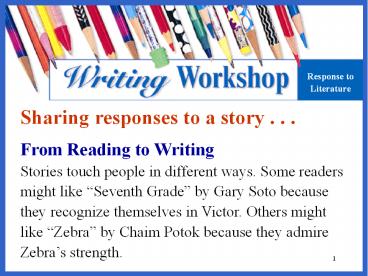PowerPoint Presentation - Response to Literature - PowerPoint PPT Presentation
Title:
PowerPoint Presentation - Response to Literature
Description:
Response to Literature Sharing responses to a story . . . From Reading to Writing Stories touch people in different ways. Some readers might like Seventh Grade ... – PowerPoint PPT presentation
Number of Views:212
Avg rating:3.0/5.0
Title: PowerPoint Presentation - Response to Literature
1
Sharing responses to a story . . . From Reading
to Writing Stories touch people in different
ways. Some readers might like Seventh Grade by
Gary Soto because they recognize themselves in
Victor. Others might like Zebra by Chaim Potok
because they admire Zebras strength.
2
Sharing responses to a story . . .
In a response to literature essay, the writer
shares his/her interpretation of a piece of
literature. The analysis may include opinions
about a character, impressions of the lessons
learned, prediction of the authors purpose,
and/or similarities and differences to ones own
life.
3
- In a response to literature essay, the writer
- shows thoughtful comprehension beyond plot
- and explains underlying meaning beyond text.
- The writer develops an analysis of the literary
- work and includes support and commentary.
4
B a s i c s i n a B o x
Response to Literature at a Glance
RUBRIC
STANDARDS FOR WRITING
Introduction
Introduces the title and author and a clear
statement of your response
A successful response to literature should
- include an introduction that names the literary
work and author and clearly states a thesis in
response to the prompt - provide a concise summary of the literary work
- contain several points responding to prompt
- support of points with story facts, quotations,
commentary, and analysis - summarize the response and provide insight of
authors purpose
Restates response and provides connection of
authors purpose to readers own lives.
Conclusion
5
As the READER reads the selection, he Or she
should contemplate
- What conflicts is the character facing?
- How does the character handle them?
- How does the character change as a result?
- What is the authors purposewhat is the
- underlying meaning?
- How can the reader connect the purpose and
- theme to his or her own life?
6
Beginning Your Response to Literature
- Prompt is the question asked about the
particular literary work. - Highlight key parts of the question.
- Focus on what the prompt is asking the writer to
do in the response.
7
Planning Your Response to Literature
1. Carefully reread the short story. As you read,
write down insights you might have. 2. Freewrite
about your responses. Spend five minutes writing
down your overall response to the story. Identify
your reactions, such as sadness, anger,
excitement, or curiosity.
8
Planning Your Response to Literature
3. Brainstorm MOST IMPORTANT WORDS.
- This is a strategy to assist the reader in
analyzing theme. - It is also helpful in contemplating the
authors purpose. - Brainstorm CONCEPT nouns. These cannot be
- experienced by your senses. They are IDEA
words.
9
Planning Your Response to Literature
3. Examples of MOST IMPORTANT WORDS
Success/ Failure Respect
Revenge Perseverance/ Apathy
Self-Worth Survival Loyalty/
Abandonment Confidence
Bravery Satisfaction/ Discontent
Friendship Discipline Greed/
Generosity Love
Character Acceptance/ Isolation
Sacrifice Motivation
10
Planning Your Response to Literature
4. Concisely Summarize the Work.
- The essay should be 25 summary and 75
- response and analysis.
- To summarize effectively, use the SOMEBODY
- WANTED BUT SO strategy.
- Imagine this strategy to be similar to a movie
- preview! It must be well-written and concise!
11
Planning Your Response to Literature
4. Concisely Summarize the Work.
SOMEBODY Identify the author and title. Give
the main character
and setting. WANTED Identify what
the main character wants.
BUT Identify conflict
that the character faces. SO
Identify what the challenges will be.
12
Writing Your Response to Literature
The writer gets to express his or her response to
the prompt. This requires understanding of the
story and INSIGHT. Identifying MOST IMPORTANT
WORDS and providing a strong SUMMARY STATEMENT
guide the writer in developing INSIGHT!
13
Writing Your Response to Literature
- Use your introductory paragraph to tell your
readers what they need to know about the story
and to introduce your response.
- Develop a clear thesis which answers the prompt.
14
Writing Your Response to Literature
- Title in quotes (story) or underlined (book)
- Authors first and last name
- Summary statement 3-4 sentences in the SWBS
format - Thesis Clear, confident answer to prompt
15
Writing Your Response to Literature
- Pick your best three ideas as answers to the
prompt. - Gather story facts to support your ideas.
- Find supportive quotes.
- Provide commentary on quote. Comment about the
relation the quote has to the point and provide a
link back to the point.
16
Writing Your Response to Literature
- Begin each paragraph with a strong topic
sentence. - Answer the prompt in each topic sentence.
- Provide proof and commentary for your analysis.
- Clearly explain and connect your support back to
- topic sentence.
17
Writing Your Response to Literature
- Restate thesis confidently and clearly
- Concisely restate points
- Show insight in relation to authors purpose and
message to readers. What is the author wanting
his or her readers to understand as a result of
watching the character handle the conflict? - Identify significance to todays readers.































